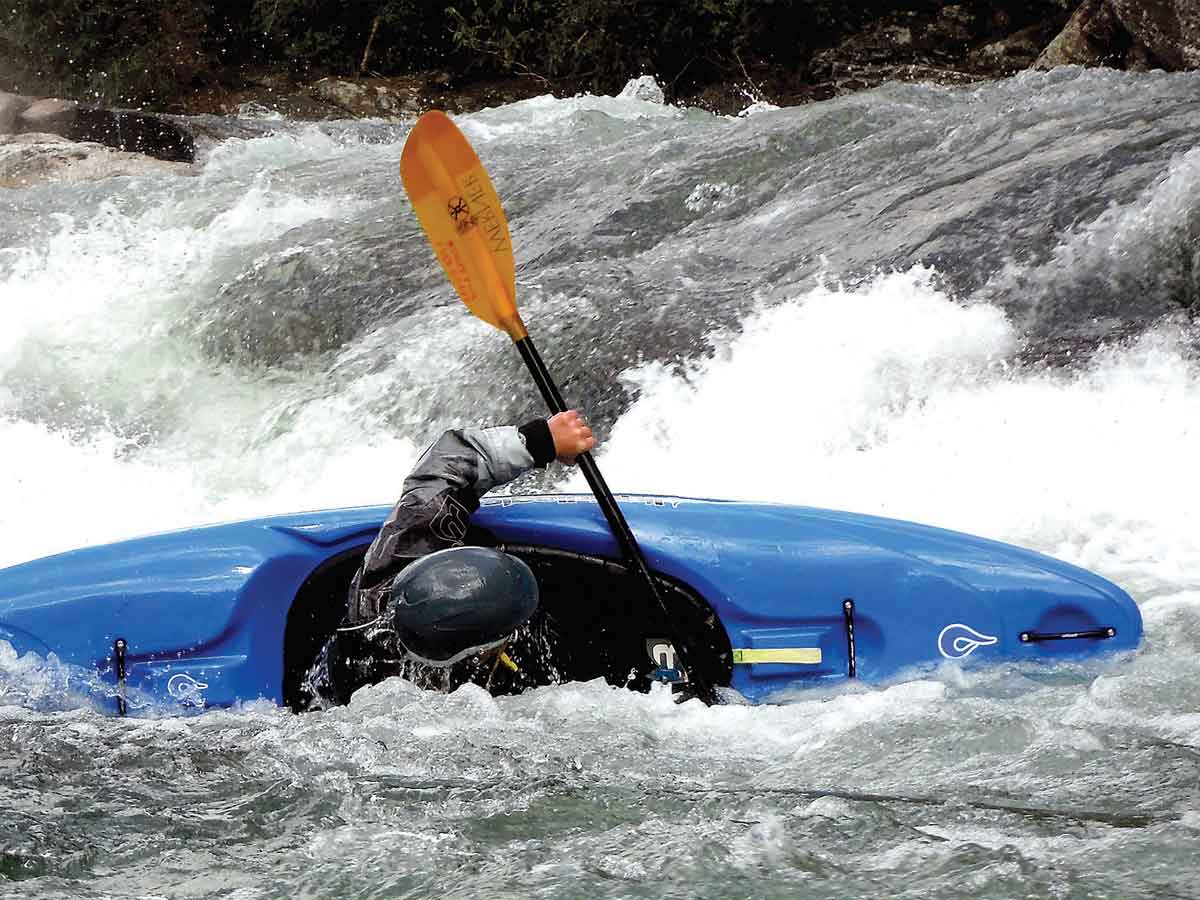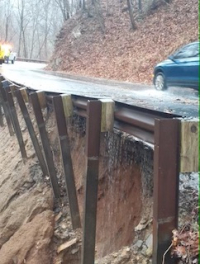‘Know what you don’t know’ : New book aims to stop backcountry emergencies before they start
 A capsized kayak at Bull Sluice on the Chattooga River shows the importance of mitigating risk when adventuring outdoors. Donated photo
A capsized kayak at Bull Sluice on the Chattooga River shows the importance of mitigating risk when adventuring outdoors. Donated photo
During his 30 years living and teaching in Western North Carolina, Maurice Phipps has heard countless tales of tragedy and near misses set in the Southern Appalachian backcountry — people falling off waterfalls , shivering in the cold while awaiting rescue after a wrong turn on the trail, or logging hair-raising experiences with wildlife .
With a lifetime of knowledge in teaching and experiencing outdoor adventure at his disposal, Phipps, a parks and recreation professor emeritus from Western Carolina University, saw an opportunity to help prevent future emergencies.
“I could put a book together with the idea of teaching about avoiding getting into a survival situation,” he said. “As far as I know, there’s no other book that does that. There’s lots of books on what to do if you get into a survival situation. That’s a really common genre. But I wanted to do something to help people avoid having to stay out overnight if they’d not planned on doing that.”
The result is “Wilderness 101: Skills, Knowledge and Fundamentals for Every Adventurer,” released this month by Falcon Guides. The 204-page book — Phipps’ fourth — is organized into eight chapters that cover various aspects of preparing for and executing a safe outdoor adventure, each with an emphasis on the five fundamentals of good decision-making: use good judgement, be here now, everything takes longer than you think, look at the Las Vegas odds of bad consequences, and know what you know and know what you don’t know.

- Maurice Phipps takes a hike on Cedar Cliff Mountain in Jackson County. Donated photo
Safety and the old mountaineer
Originally from England, Phipps’ fascination with the outdoors took root when he was a teenager, through experiences at the country’s outdoor education centers.
Related Items
“In England, the outdoors, outdoor pursuits and outdoor education is a really big thing, even though the weather is terrible,” he said.
He went to an outdoor center when he was 14 and again at age 16, later working in one after graduating from Sheffield College of Education to become a teacher. Phipps’ life took several adventurous turns after that, including three years spent in Australia exploring its rivers to co-write his first book “Canoeing in Australia” and competing in national slalom and wildwater racing events. From there, he returned to Britain, attained an advanced diploma in physical education and started an outdoor pursuits company in North Yorkshire, which he ran for five years.
Phipps came to the United States in 1981 to continue his studies, completing additional graduate courses and a Ph.D. in education. He also took a Wilderness Education Association course taught by Paul Petzoldt , the famed mountaineer and outdoor educator who founded the National Outdoor Leadership School , which even today is the standard-bearer for all manner of outdoor leadership and safety certifications.
“He’s a phenomenal guy from the point of view of outdoor education in this country, so I was lucky to be on this course that he was teaching,” Phipps said.
The next year, Phipps apprenticed with Petzoldt as an instructor, and after that he worked with him as a Wilderness Education Association course director. Petzoldt died in 1999, but the lessons Phipps learned from him remain at the core of how he approaches the outdoors — and of the messages he conveys in his newest book.
Petzoldt liked to emphasize the importance of safety, Phipps recalled, by saying that, “we all want to live to be old mountaineers.” Reaching his 99th birthday before he passed away, Petzoldt achieved that goal.

- Cloud shrouds Mt. Buffalo in Victoria, Australia, showcasing the wild elements of the wild outdoors. Donated photo
Know before you go
Phipps begins his book by discussing the motivations that lead people into the outdoors. Some people are in it to join what he calls the “selfie club,” while others are looking for adventure, an adrenaline high or pursuit of the hero archetype. Those motivations can lead to risky behavior.
“We should use the child archetype instead, so they should do things for fun,” he said.
The second chapter discusses terrain, skills and equipment. The skills and equipment needed for any given adventure differs depending on where that adventure takes place. Phipps details various types of environments an adventurer might go and gives emergency prevention techniques for each one.
Next, he discusses climate, weather, clothing and energy.
“Those are all linked. The energy in your tank, which is water and food, keeps you warm. It also gives you energy,” he said. “So if you don’t eat and drink at the right times, you’re going to lose energy and just sit on the side of the trail. Some people have got hypothermia and just sat and died.”
The fourth chapter covers problem wildlife, something Phipps has ample experience with, having lived on three different continents. He’s dealt with stingrays, barracudas, deadly spiders, a “frisky” emu and, in the Grand Tetons of Wyoming, an inquisitive porcupine that wandered into his tent when he mistakenly left the door open.
“If we jumped into the tent like you sometimes do, we would have gotten a face full of quills,” he said.
Luckily, he noticed it go in and was able to guide the creature out with a long stick.
Phipps then discusses skills and procedures for different activities, including hiking, camping, cooking, kayaking and caving, to name a few. For instance, choosing a campsite is a skill in and of itself. Ensuring the campsite is away from stored food and not underneath one of the loose hanging branches often called “widowmakers” can prevent a fair number of emergency situations.
The book then gives a nod to Petzoldt with a chapter on his control plans to minimize risks in the backcountry. These plans are designed to reduce the risk of common types of emergencies. The climate control plan deals with how to ensure “your personal climate” stays at 98.6 degrees regardless of the weather, while the time control plan helps adventurers estimate how long it might take for a group of people to complete an outdoor task. The energy control plan deals with ensuring you’re consuming sufficient foods and liquids, while the health control plan aims to prevent sickness and infection.
When he used to take groups of WCU students in the backcountry, said Phipps, “we were really particular that students wash their hands up when they go to the bathroom, not share drinks and stay clean. We don’t have any caveman ethics, so you’re less likely to be evacuated because you have stomach problems. A couple of the most common reasons for evacuation are infections and stomach problems.”
The remainder of the book — chapters seven and eight — details how to protect the environment through Leave No Trace outdoor ethics and how to learn more about outdoor adventuring and skill development.
“I’m just hoping it’s going to save people a lot of aggravation of having to have an evacuation or to save them from dying out there,” said Phipps. “There are a lot of people who die out there because they don’t know what they don’t know. If a lot of lay people read this, they’ll make a more informed decision about what they’re doing.”

Buy the book
“Wilderness 101: Skills, Knowledge and Fundamentals for Every Adventurer” retails for $14.95 at local bookstores and major booksellers.
Phipps’ other titles include “The Group Book: Effective Skills for Cooperative Groups,” “Outdoor Instruction: Teaching and Learning Concepts for Outdoor Instructors,” and “Canoeing in Australia.”









